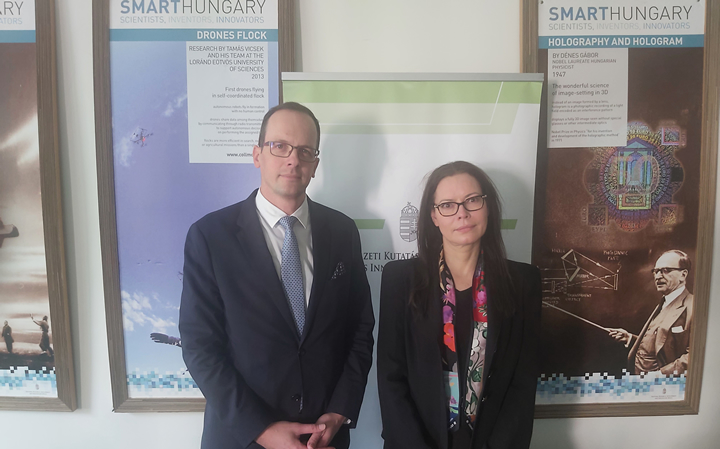One of the cornerstones of the European Union’s approach to research and development is the coordinated development of existing and emerging research infrastructures. The process is coordinated by the European Strategy Forum on Research Infrastructure (ESFRI), headed from 1 January 2022 by Slovenian researcher Jana Kolar.
Dr. István Szabó, Vice President for Science and International Affairs of the NRDI Office, received Jana Kolar, Chair of ESFRI, and the representatives of 5 Hungarian institutes invited to the talks, who are also the scientific representatives of international research infrastructures.
In her presentation, Jana Kolar pointed out that until the 2000s, the European research infrastructure map was mostly fragmented. The situation, however, changed in 2002 with the creation of the Forum, which has a unified strategy, manages multilateral initiatives, prepares a comprehensive European plan and monitors the implementation process. The Forum’s success is marked by the celebration of the 20th anniversary of its creation in March this year, in the framework of the French Presidency’s programme in Paris.
The NRDI Office invited to the roundtable five national experts from research infrastructures through which we could demonstrate to the ESFRI Chair our long-standing and recent links to the international research infrastructure ecosystem.
BBMRI ERIC and ICOS ERIC as our latest affiliations, European Spallation Source ERIC and European Social Survey ERIC as our multi-year memberships, and EuPRAXIA as our affiliation to an emerging international research infrastructure initiative were presented.
- BBMRI ERIC (Biobanking and Biomolecular Research Infrastructure) aims to support the development of new, effective therapeutic treatments by aligning the needs and opportunities of researchers, industry and patients in need of treatment with related biomedical research. As part of this, the Hungarian organisation provides high quality management services, advice on ethical, legal and social issues, and IT support to participants in research programmes. The coordinator of the BBMRI node in Hungary is Semmelweis University, and other participants are the University of Szeged, the University of Pécs and the South Pest Hospital Centre.
- ICOS ERIC (Integrated Carbon Observation System), the main European research infrastructure for climate and atmosphere research, was also presented. ICOS aims to conduct long-term studies to better understand the global carbon cycle and collect reliable data on greenhouse gas changes through the coordinated operation of its growing network of nearly 150 atmospheric, ecological and ocean observatories, using standard measurement methods. Hungary joined the international scheme on 1 January this year, extending the network to the Carpathian Basin. The national coordinator of the network is the Institute for Nuclear Research (ATOMKI), which aims to provide scientists, decision-makers and journalists with up-to-date data.
- The ESS (European Spallation Source) in Lund, Sweden, is one of the EU’s largest ongoing research infrastructure investments and will be the largest of its kind in the world with its new generation, high-energy particle accelerator-based neutron source. Most of the buildings will be available in 2022, but the infrastructure will only be fully operational in 2027. Hungarian researchers and engineers are involved in the design and construction of five facilities, at a total cost of around €42 million. In Hungary, the Nuclear Research Institute, the Energy Research Centre and the Wigner Centre for Physics are involved in the project.
- EuPRAXIA, included in the ESFRI Roadmap 2021, will be an innovative electron accelerator based on distributed plasma technology. The plasma needed for acceleration will be generated by using either lasers or fast electrons. The equipment can be used to study questions that are fundamental to biological and medical research, such as cells, proteins or pieces of DNA. In Hungary, the use of the EuPRAXIA research infrastructure is expected to enable the high-quality research work of nearly 200 medical, biological, life sciences, physics and materials science professionals, and a large number of engineers, IT and biomedical technicians to be involved in the construction and operation of the infrastructure. Hungarian participants include the Wigner Research Centre for Physics and the Universities of Pécs and Szeged.
- Hungarian researchers have been participating in the European Social Survey (ESS) since its inception, which is a European survey in the field of sociology and political science. The network aims to provide reliable and independent data to the media, socio-economic, social psychology and innovation researchers. The organisation also organises data visualisation competitions, with the Hungarian coordinator being the Centre for Social Sciences.
The excellent Hungarian research infrastructures, which are also significant by international standards, were awarded a certificate of recognition last December by Minister László Palkovics and Dr. István Szabó, Vice President of the NRDI Office. Within the RDI ecosystem, research infrastructures play an important role in both basic and exploratory research, contributing to the growth of Hungary’s economic performance through their scientific outputs.







